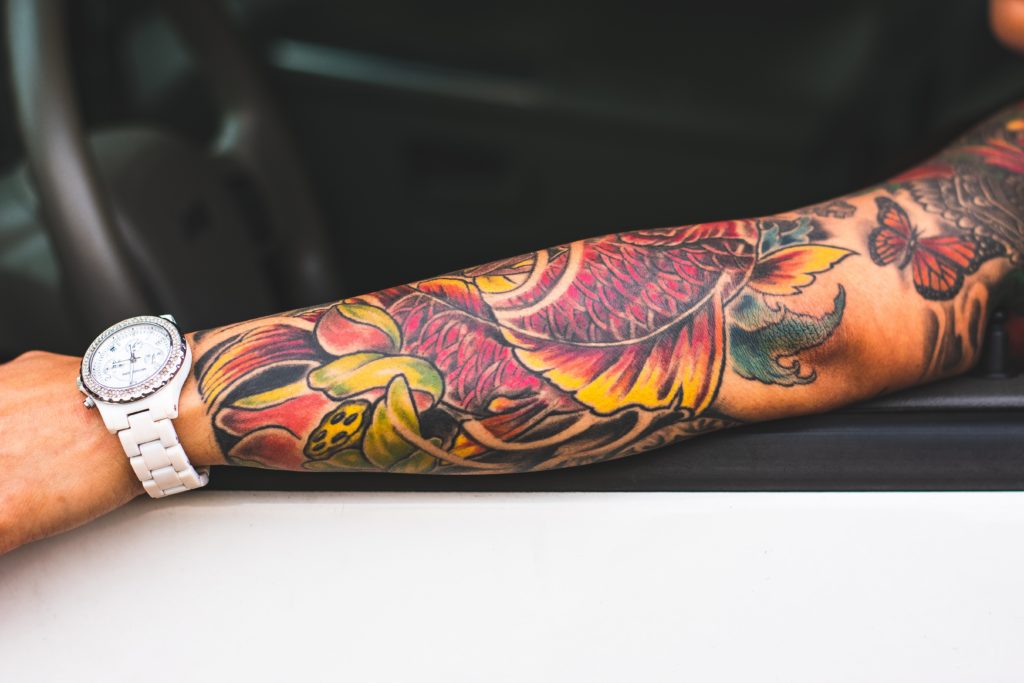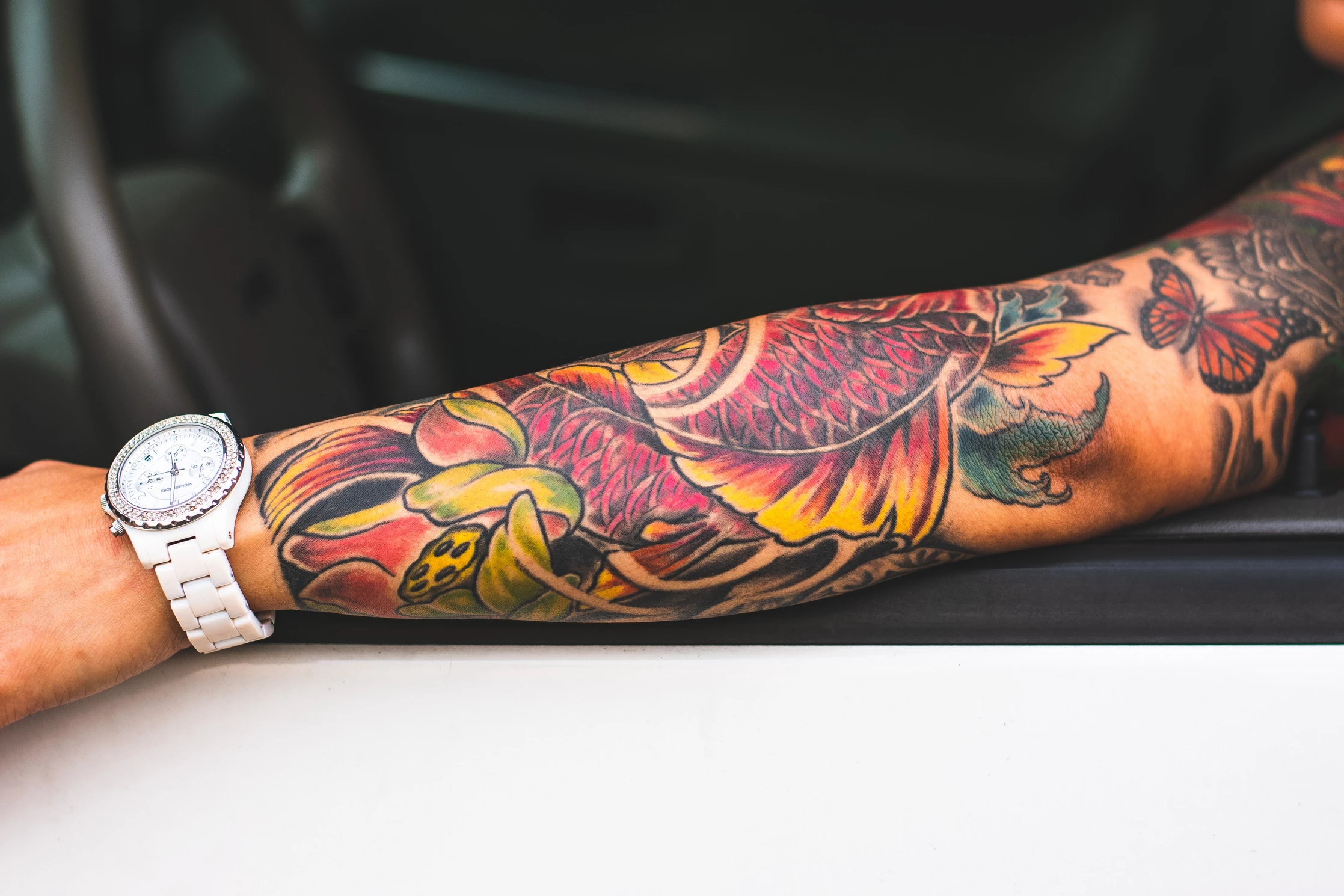The truth about tattoos on aging skin.
So, you are 4 to 6 weeks in. You have a fully healed new tattoo and you are really pleased with it. Actually, you are absolutely ‘stoked’. It’s bright, it’s clearly defined, it expresses everything you wanted it to, … it has exceeded expectation (like every tattoo should). Now is the serious business of maintaining your new pride and joy so it keeps its colours bright and outlines sharp for life.
BIG STATEMENT considering you are a living organism that is ‘aging’ by the minute (literally).
Maintenance may sound like a boring tedious task, but you will be doing no more than you should for any other part of your body with exposed skin. It’s about looking good for as long as you possibly can. So, let’s explore –
- what will probably happen to your tattoo as you celebrate birthdays in the decades ahead,
- whether or not you can realistically change what’s going to happen as your human canvas ages.
The Tattoo process and the truth about tattoos on aging skin.
How will my tattoo look when I’m old? … it depends. Aging is a very complex process, but we will try to break it down so it makes sense.
Aging skin is caused by a multitude of things happening –
- There is less skin cell renewal.
- The skin cells that do renew are replaced by skin cells that are infinitesimally inferior to their predecessor. The new skin cells have less collagen and less squalane, so the the skin is more relaxed and less tight.
- Aging skin produces less natural oils so it gets drier. Dry skin produces flakes and make tattoos appear grayed or muted in colour.
- Bone density declines and muscle mass diminishes after you turn 30 at between 3% to 5% per decade. This means the solid foundation supporting your skin decreases.
The combination of these processes creates wrinkles and ‘you look older’. BUT, there are things you can do to hold off the aging process (so keep reading….)
The Most Important Things for Maintaining Tattoo Quality
1. Healthy Diet
Eat a healthy balanced diet. Make it colourful so you increase your consumption of vital micro and macro nutrients, vitamins, minerals and trace elements. Make lots of leafy greens and vegetables a feature of every meal as they contain a lot of water that are loaded with nutrients! Consuming good quality proteins so you are ensured of eating enough amino acids (the building blocks used for repairing muscles, bones and other essential processes). And, of course calcium for strong bones.
Avoid highly processed foods with high fat, sugar, salt and trans fats.
2. Exercise
Exercise for 20 to 30 minutes per day. Add some resistance training to maintain healthy, strong muscles and bones.
3. Hydration
Many people are dehydrated and don’t even know it. Keep you body well hydrated by drinking water.
Avoid Tea, coffee, alcohol and high sugar soft drinks.
4. Moisturiser
The primary role of tattoo cream is to prevent moisture loss in the skin. As you drink water, you hydrate from the inside. The goal of a good cream is to slow down dehydration as much as possible by locking in the moisture you have either eaten or drank.
Without a good natural tattoo cream you run the risk of letting valuable moisture escape. Moisture leaving your body every day when sedentary is approximately –
800 mls urine
300 mls water diffusion
600 mls sweat
200 mls vapour from breathing
1900 mls TOTAL MOISTURE LOSS PER DAY (approximately)
*** This is why there is a recommendation stating people should drink around 2 liters of water a day (do your research to determine how much you should be drinking).
Remember, skin cells kept in optimum condition by using a good quality cream will continue to reproduce inferior replacements, BUT if you neglect to moisturise at all you may be accelerating the degenerative process.
5. Fading and the truth about tattoos on aging skin.
Ink (tattoo pigment) is injected and held in the dermis (the middle of your three layers of skin) by single white blood cells called ‘macrophages’.
These immune-response blood cells swarm towards the area of your new tattoo when the needle punctures your skin.
The cell then envelopes the pigment and protects your body from it as it believes the pigment is a foreign invader. It sits there in the dermis, dies (in a few years) and becomes part of the regenerative process of rising to the surface to become dead skin which falls away to make room for the next generation of new skin cells. But, before they leave the dermis they release the pigment they contain and leave the colour behind under your skin! Amazing! The free floating pigments are then picked up by neighbouring macrophages which are the only cells capable of dealing with them. These unique white blood cells are very special as they become part of a extracellular recycling program which enables the tattoo pigment to become a permanent part of your cellular network without pushing the pigment out in the natural skin renewal process.
Touch up.
Smaller tattoos (especially those with finer line work) age more quickly. They get blurry and less defined. It’s the larger, bolder tattoos that age well.
That’s just the skin canvas! Now we have to discuss the structure underneath that canvas; your bones.
There has been irrefutable scientific evidence that as we age our bones ‘thin’ and the actual structure of our body changes. Hence why a thousand year old skeleton can be dug out of a desert somewhere and while the scientists are leaning on their shovels, they can determined the sex and approximate age of the person at time of death.
For this reason it is very important ‘where’ you place you tattoos if you want them to look half decent when you are a senior citizen. The fact is as your bone structure naturally thins and loses volume, the muscle attached to bones moves to compensate for the change and sits differently. The skin then has to make adjustments and drapes differently to accommodate the change. It’s not all about loss of soft tissue and elasticity. Can you do anything about a naturally degenerative bone structure? Yes, you can slow it, but you can’t stop it. It has been scientifically proven that vegans live 6 years longer than non-vegans apparently. So, become vegan!
You can however implement a preventative strategy and potentially slow the speed of the aging processes by –
- eating balanced nutritious meals
- avoiding cigarettes, alcohol, drugs
- doing weight-bearing exercises
- staying active
- and looking after your healthy and well-being in general (including your mental health)!
YOUR JOB: The KEY THINGS NEEDED for Tattoo Health
1. Eat high quality fresh food
2. Protect skin from the sun
3. Exercise regularly (including resistance)
4. Drink water
5. Get good sleep!
OUR JOB: …. is number 6. Replace lost goodness
By using Tattman’s Vegan Tattoo Aftercare daily, you get optimum results by replenishing lost essential vitamins, minerals and trace elements. Most importantly moisture is locked in with the purest, natural plant-based ingredients, and the elements that decline with age (like squalane) are replaced as much as possible.

The truth about tattoos on aging skin.

